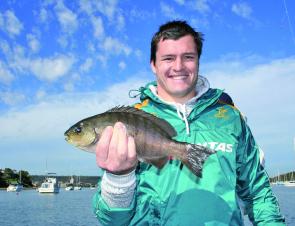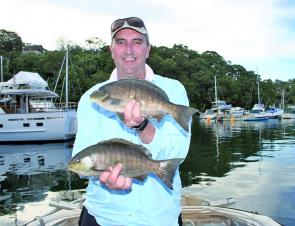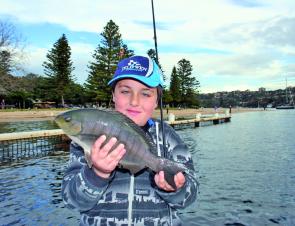Having survived the ravages of commercial fishing and pollution a lot better than most other species, luderick are still quite prolific in Sydney Harbour.
They fight well, are great to eat and are found through a range of habitats from the most tranquil estuary reaches to harsh ocean rocks.
They are well within reach of shore-based anglers, it’s inexpensive to set up tackle for them and they’re a year-round proposition.
Luderick have adapted to, and probably even benefited from, human-made structures. The myriad moorings, pylons, breakwalls, marinas and jetties provide them food and shelter from natural predators and from commercial netting.
They are found as far north as south-east Queensland right along the NSW coast and around as far as south-western South Australia.
They have also been found in northern Tasmania and are known as parore in New Zealand.
Luderick do require specific techniques that can take considerable time to learn but once they are mastered, the fish flow freely.
Here's a bit of information on tackling up for blackfish that might help short-cut the initial learning curve.
The tricky bit to blackfish angling is in the control of the rig.
Light floats, long drops, wind-resistant baits and lots of sinkers add up to a rig that demands constant attention.
There are two ways to go, each with good and bad points.
You can opt for the running float rig of a standard, long-stemmed blackfish float free to run on the line.
It's stopped a certain distance from the hook by a split shot and prevented from running all the way up the line by a stopper of light string tied to the line or any one of a number of commercially produced rubber stoppers.
The main criterion for a stopper is that it clamps tightly enough to the main line to stop the float sliding any further than you want it to but still must be loose enough that it can be moved up or down to change the depth of the drop.
A good stopper must also be able to be wound through the rod guides, sometimes even onto the reel, and cast back out again without snagging.
The main advantages of the running-float rig is that the length of the drop from the rod tip can be as short as a couple of feet and the maximum depth of the drop below the float is infinite.
This makes it an easy rig to cast farther than the alternative, but this rig is prone to tangling because the wind-resistant bait is very close to the float during the cast.
The fixed-float alternative has a split shot clamped above and below the float to restrict its movement along the line. It is fixed at the full depth you are fishing.
The problem with this rig is that if you are fishing at, say, 3m or more you will have that full 3m of line hanging from the rod tip – difficult to handle.
The fixed rig is that is much less prone to tangling during the cast because the bait is so far from the float. I use this method most often.
Obviously, if you are fishing deeper than about 3.7m this rig is not applicable, but this does not occur very often.
Weighting of the float is critical. Most floats consist of a thin stem with a streamlined float of cork or foam about two-thirds of the way up the stem.
The float must be weighted so that the cork or foam section is underwater, leaving just the stem above the float showing.
The float is weighted with split shot, running sinkers, strip lead around the stem of the float or a combination of these.
Conditions dictate the size and weight of the float to use. In windy, rough water you will need a big, heavy float and in calm conditions, the smaller the float the better. A quill float makes an ideal still-water float.
When to strike is a point of hot debate among luderick fishos; my opinion is that there is no hard and fast formula.
If they are biting voraciously, strike quickly; if they are feeding tentatively, give them a bit more time.
Generally, it is a good idea to wait at least until your float is completely under water before striking.
Sometimes blackfish eat a bait and just sit there, in which case your float will hardly move. If you see some unusual movement on your float but it doesn’t go under, it might just be worth striking on spec.
On very rare occasions a fish will eat your bait and swim up the water column. This is common if you are berleying heavily as the fish comes up the burley trail for its next feed.
With the weight now off the float, will lie on its side – also time to strike.
Rods for luderick are long and soft for a number of reasons. They are long because of the need to handle the long drop often used under the float, and the extra length also helps to lift the belly of line caused by cross-current or wind when you go to strike.
On a long drift, the belly can become so severe that the strike serves only to lift out the belly and sometimes never reaches the float.
The rod must be soft because the blackfish's mouth is small, as are the hooks used. A stiff rod would pull the hook clean out of the fish’s mouth.
The long rod offers the cushion needed to prevent this happening during the luderick’s strong lunges.
Choice of reel is up to you. I’ve seen egg-beaters, baitcasters and centrepins used successfully and centrepins are still used on a traditional basis rather than on their practicality. If you opt for a centrepin, go for a more versatile sidecast reel such as an Alvey luderick model.
I use threadlines, which offer open-face casting, a fast retrieve (important when picking up belly before striking) and the ability to feed line smoothly to the float to allow it to drift.
For smaller river blackfish, 6lb line and a No 8 or No 10 hook will suffice.
The big ocean bronzies require heavier tackle and a No 6 hook with 10lb or 12lb line would be more appropriate.
There are situations when low-stretch braided line is good but not for general blackfishing, where you can easily tear the hooks out of a fish.
But gelspun lines float, a huge advantage when picking up belly off the surface so braid makes excellent blackfish line in experienced hands holding soft rods.
Although they can be caught year-round, blackfish are at their best during the cooler months and don't seem to mind cold, still, clear water.
These are schooling fish so when a concentration is found they can be taken in good numbers.
Upstream, they have a preference for deep water and can be found around weed beds, rocky points, channel edges and structure like bridges, jetties and retaining walls. Downstream they are commonly found around reefs, rock ledges and breakwalls.
When selecting a spot to fish, consider that you need a bit more room when float fishing. Pulling up to a structure already crowded with lure or bait fishos and setting up a blackfish drift is a recipe for crossed lines and tempers.
I’ve seen experienced blackfishos lined up shoulder to shoulder fishing a drift from the shore. When the last bloke gets to the end of the run he pulls in and goes back to the start of the line for a fresh drift.
This system only works if everyone is fishing for blackfish and all are experienced. It doesn’t appeal to me and I’m not sure why it’s necessary when there is such an abundance of good blackfish spots around our major cities.
Occasionally blackfish are taken by bream or whiting anglers on worms or yabbies but primarily they are vegetarian.
The most common baits used are cabbage weed or river weed.
Cabbage is found on ocean rocks and the intertidal zone on the lower reaches of our rivers and harbours. It is best when it is used in the areas where it is found and likewise with the river weed, which is located in the upper reaches near the tidal limit and into the fresh.
Having said that, river weed often works well throughout the system, even around the washes on the lower reaches.
River weed can often be purchased through bait outlets, with Parramatta River weed popular statewide.
I have never seen cabbage weed available in shops so you will have to collect it yourself at low tide. Be careful of the ocean swells.
Typical of intertidal feeders, blackfish bite best on the two hours up to the high and the first two hours of the run out.
A berley of chopped weed and sand dispersed by the handful every five or so minutes will vastly improve catches.
Luderick are respectable fighters, maintain a good average size (around 600g) and, when skinned and filleted, are an excellent feed.
Reads: 9703
Wallabies fullback Adam Ashley-Cooper with a Harbour blackfish.

In calm water like this you can go to just a quill float to catch quality fish like these.

In the more turbulent conditions of the lower Harbour it’s wise to use more bulky floats and more weight.

Luderick just love to hang around structure, whether it’s artificial or natural.




